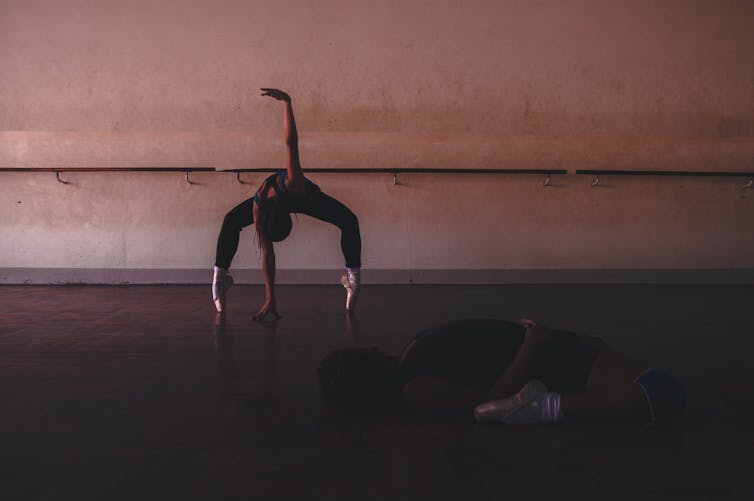
Artists all over the world, regardless of their gender, earn considerably less than professionals in occupations requiring similar levels of education and qualifications.
But there’s an additional income penalty for artists who are female.
In an analysis of gender differences in the incomes of professional artists in Australia that we undertook in 2020, we found the creative incomes of women were 30% less than those of men.
This is true even after allowing for differences in such things as hours worked, education and training, time spent in childcare and so on. This income penalty on women artists was greater than the gender pay gap of 16% experienced in the overall Australian workforce at the time.
Some sectors of the arts have tried to redress this problem. However, women continue to suffer serious and unexplained gender-based discrimination in the artistic workplace.
Cultural differences are also known to influence pay gaps in many countries.
In new research out today, we considered whether cultural factors might also affect the gender pay gap of artists in Australia. In addition, we analysed the gender pay gap for remote Indigenous artists for the first time.
Read more: Why is the gender pay gap in the arts so large? Widespread discrimination is the most likely cause
A larger gap for women from a non-English speaking background
In our 2016 survey of 826 professional artists working in metropolitan, regional and rural Australia, we asked participants if they came from a non-English speaking background.
Only a relatively small proportion of artists – 10% – came from a non-English-speaking background, compared to 18% for the Australian labour force as a whole.
A non-English-speaking background appears to carry an income penalty only for women artists, not for men.
We found the annual creative earnings of female artists from a non-English-speaking background are about 71% of the creative incomes of female artists whose first language is English. But there is little difference between the corresponding incomes of male artists.
Within the group of artists from language backgrounds other than English, the annual creative earnings of female artists are about half (53%) those of their male counterparts.
By contrast, the ratio of female to male creative earnings among English-speaking background artists is 73%.
These results suggest that women artists from a non-English-speaking background suffer a triple earnings penalty – from being an artist (and hence as a group earning less than comparable professionals), from their gender, and from their cultural background.
Despite this earnings disadvantage, 63% of artists who identified as having a first language other than English thought their background had a positive impact on their artistic practice. Only 16% thought it had a negative impact.

When artists were asked whether being from a non-English speaking background was a restricting factor in their professional artistic development, 17% of women answered “yes”, compared to only 5% of men from a similar background.
Nevertheless, like their male colleagues, these women artists continue to celebrate their cultural background in their art. They contribute to the increasingly multicultural content of the arts in Australia, holding up a mirror to trends in Australian society at large.
Read more: Screen Australia celebrates its work in gender equality but things are far from equal
No gender gap in remote Indigenous communities
For First Nations artists working in remote communities, a different picture emerges.
For this research, we used results for remote communities in three regions of northern Australia drawn from our National Survey of Remote Aboriginal and Torres Strait Islander Artists.
The gender gap is not replicated among remotely practising First Nations artists.
There are some minor variations in this finding for subgroups in different regions, depending in part on differences in the mix of visual and performing artists in the population. But whatever other differentials may exist between female and male earnings, they do not appear to be attributable to the sorts of systemic gender-based discrimination that affects the residual gender gap for other Australian artists.
A possible reason relates to fundamental differences between the cultural norms, values and inherited traditions that apply in remote and very remote First Nations communities.
Gender roles in Aboriginal and Torres Strait Islander communities have been described by researchers as distinctively different, rather than superior or inferior. The importance of both women and men as bearers of culture has been clearly articulated.
The unique cultural content of Aboriginal and Torres Strait Islander music, dance, visual art and literature is an essential feature of the work of these artists. These characteristics pass through to the marketplace, and there does not appear to be any obvious gender gap in the way the art from these remote communities is received.
There is always differentiation between the art produced in different remote regions of Australia which varies depending on the complexities of different inherited cultural traditions. But there is no indication of any gender-based discrimination associated with these regional differences.
David Throsby receives funding from the Australia Council for the Arts , Australian Research Council (ARC), and from the Commonwealth, WA, NT, SA and QLD governments.
Katya Petetskaya receives funding from the Australia Council for the Arts, Australian Research Council (ARC), and from the Commonwealth, WA, NT and QLD governments. She is affiliated with NAVA.
Sunny Y. Shin receives funding from the Australia Council for the Arts.
This article was originally published on The Conversation. Read the original article.







